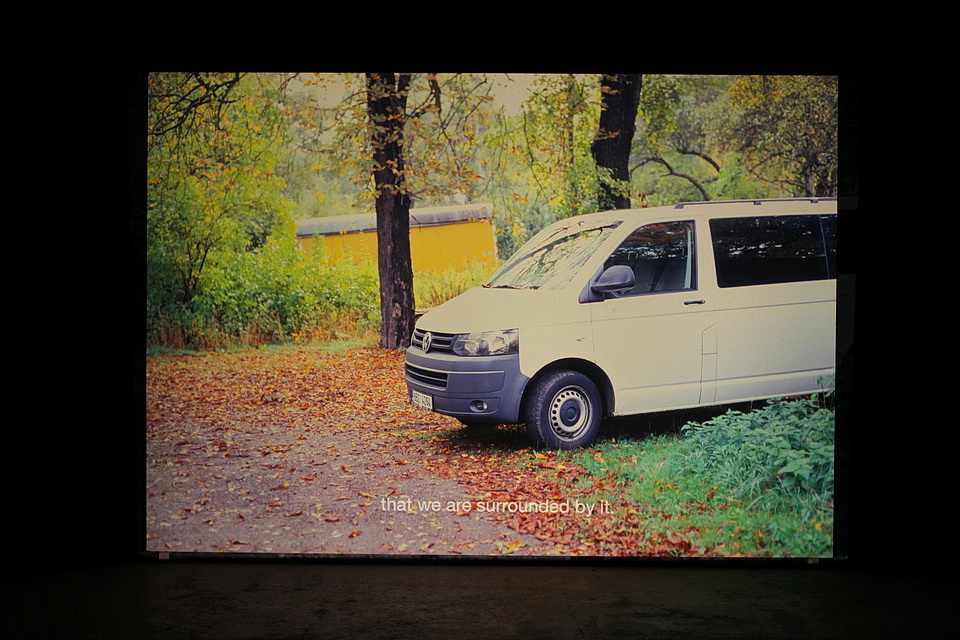4/11 2015, Den otevřených dvěří Ateliéru intermédií FaVU VUT Brno, 13:00–19:00, Údolní 19.
První ateliérová schůzka je ve středu 23/9 13:00, místnost 316 (Údolní). Prosíme o dochvilnost!
Novým vedoucím ateliéru bude od 1. září 2015 umělec Pavel Sterec.
Untitled (Hindsight bias) – installation views (Spinnerei)
Untitled (Hindsight bias). (Single screen) 35mm double slide projection in asynchronous endless time loop, 2013
Werkschauhalle (Spinnerei), Spinnereistr. 7, Leipzig, 15 November — 20 December 2013
Installation shot (on-line video preview): http://intermedia.ffa.vutbr.cz/untitled-hindsight-bias-double-slide-proj...
■
(...) An interest in experimenting with the development of a story over time and its principles brings Ján Mančuška closer to Filip Cenek. For Cenek’s output the determining factor over the past fifteen years has been the exploring of non-linear story-telling. His work in the moving image domain was originally kick-started by the opportunities offered by computer technology and digital post-production which make the construction of non-linear narration easier.* Unlike Mančuška, Cenek is critical of the effects of sequential story-telling on the mind of the viewer — we tend to automatically connect juxtaposed or sequentially following elements into higher entities. We are convinced that the meaning of what we watch on the screen constitutes a single dramatic arch, a linear story construction going back in its tradition to the ancient Greeks. However, many of Cenek’s works try to show that moving images need not have this higher meaning or do not have any whatsoever: it is the spectator who forms the connections between random elements and creates them into a meaningful story. In order to be able to demonstrate this ability Cenek, instead of analytically investigating the language of moving images, more and more often resorts to working with randomness. The structure of his works does not remind us of the clearly set, although branching out, sequential elements as with Ján Mančuška, but rather it has the characteristics of an unorganized archive which can be browsed in an unlimited number of ways. The foundation of Cenek’s installations such as Shiner (Třpytka, 2008/2010, with Tereza Sochorová), Wonky Cinema (Vratké kino, 2011) and others are two carousel slide projectors, one with photographs, the other with text subtitles. Images from both slide projectors merge on a single projection screen creating a changing asynchronous time loop. The automatically controlled slide projectors connect random images with random subtitles within the full scale of the existing combinatory options. However, the viewer reads the resulting projection as a unique story created based on a script prepared in advance. It takes some time, and study of the projection apparatus, before he finally understands that the story narrated through confronting images and text is only created in his own mind. The impressiveness of the work is underpinned by the photographic quality of the black and white slides and the other elements of the installation that the viewer is directly confronted with: the rhythmically clicking slide projectors, the light emanating from them and the typical smell of hot plastic. Also refreshing, and for the reading of the work essential, is the analogue mechanics of the apparatus pairing up images and text.
While Cenek usually employs film’s means of expression to create his non-linear narration — an accidental montage of shots, succession of photos and subtitles — Ján Mančuška often starts from a story mediated through verbal narration. Afterwards, this is transformed into film or spatial installations. In contrast with Cenek, Ján Mančuška believes that even non-linear narration may define a story with a meaning, or at least the heroes of his films and theatre play continually search for it. In the world of fragmentary, multi-linear or backward-running stories they are in search of their unique meaning, among the options of a single direction relevant to their situation. They want to know how things took place and what they mean.
— Tomáš Pospiszyl: An Associative History of Art. Tranzit.cz, Prague, 2014, pp. 178–180. ISBN 978-80-87259-28-3. From the chapter ‘Visual Art in a Moving Frame’.
* Filip Cenek is a trained film projectionist. In hindsight, he describes the experience of screening classic films as formative. In the projection booth he realized hands-on that film is not merely a moving image on the screen as it seems to the ordinary viewer, but a complicated spatial situation.
